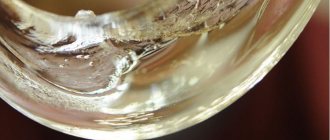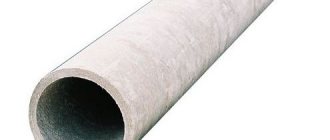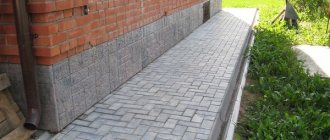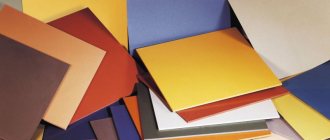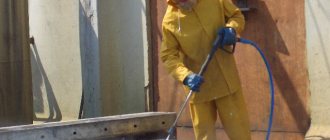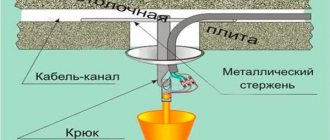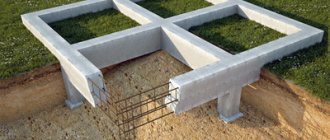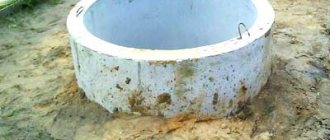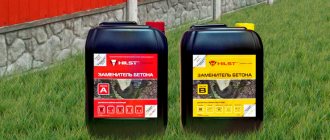Ceresit CE 40 Aquastatic grout is intended for joints up to 10 mm wide. It is water and frost resistant. Can be used for grouting joints in a bathhouse after laying tiles along with such grouts as Ceresit CE 33 Super and Ceresit CE 35 Super.
CE 40 Aquastatic - elastic water-repellent grout for joints up to 10 mm
Properties
- Available in 30 colors, including white;
- has an enhanced antifungal effect (Trio Protection “Micro Protect” formula);
- water-repellent (Aquastatic effect);
- resistant to dirt, easy to clean;
- elastic, resistant to deformation;
- has high color fastness;
- perfectly smooth;
- water- and frost-resistant;
- can be used on heated floors;
- suitable for indoor and outdoor use;
- environmentally friendly.
Additional recommendations
If ceresite has thickened, you can add a small amount of water to it and mix thoroughly until smooth. It is not recommended to dilute it to a more liquid state than it was when purchased. Otherwise, you will have to increase the number of layers applied, and the drying time for each can reach 5-6 hours.
There are the following recommendations for the use and storage of this building coating:
- When working with primer, it must be stirred periodically so that it maintains a uniform structure and does not delaminate.
- Concrete contact is considered waterproof, but if moisture comes from the base, it can peel off along with other building coatings applied to it.
- After drying, excess primer can only be removed with a solvent - it is very resistant to mechanical stress, so it will not be possible to scrape it off.
- You can store the product in a sealed package in a dark and cool place for a year without worrying about its condition, but it is advisable not to leave an open container with ceresite for more than a week. In view of this, it is recommended to approximately calculate the required amount before purchasing, so that after priming is completed, as little excess product as possible remains.
- It is not recommended to apply it with a roller - the product is quite thick, so this tool will be inconvenient to use in this case.
Only the winter version of concrete contact can be frozen. Failure to comply with this condition may result in changes in the properties of the product and deterioration in the quality of adhesion.
Application area
Grout CE 40 Aquastatic is intended for filling joints of ceramic, stone (including marble) and glass cladding on floors and walls inside and outside buildings, with a joint width of up to 10 mm. Due to its high elasticity, the grout can be used on deformable substrates (chipboards, particle boards, plasterboard, etc.) and substrates subject to temperature fluctuations (heated floors, terraces, outdoor swimming pool baths, etc.).
Thanks to the “Aquastatic” effect (hydrophobic properties) and the “MicroProtect” formula (high resistance to fungus and mold), CE 40 grout is optimal for use in rooms with constant humidity: bathrooms, showers, kitchens, etc.
It is recommended to fill corner, expansion joints and joints adjacent to sanitary equipment with silicone grout CS 25.
Ceresit mixtures
- Ceresit glue (Ceresit tile adhesive);
- Waterproofing Ceresit;
- Decorative plaster Ceresit;
- Ceresit tile adhesive.
It is worth noting that adhesive mixtures and cement-masonry mixtures are an indispensable element in construction. Ceresit adhesive and Ceresit waterproofing are leaders in the building materials market due to their performance and substance composition.
Technical characteristics of Ceresit
Decorative plaster
Decorative plaster - dry plaster mixture, as it is also called, is an indispensable final process in construction and repair. Wall plaster levels the walls. Gypsum plaster is used as a wall covering after the priming process. After covering the walls with a plaster and adhesive mixture, the plastered surface is subjected to a cladding process: covering with facing bricks or covering the walls with wallpaper. Dry plaster mixtures are used in rooms with high humidity, and also in dry plaster-cement-sand mixtures, polystyrene foam additives are also added to increase the thermal insulation of the solution. Dry gypsum plaster mixture is a new and technologically advanced masonry material.
| This gypsum plaster mixture regulates the microclimate of the premises and protects against humidity; |
| Dry plaster mixtures for interior work do not require reinforcement and are not prone to shrinkage; |
| The dry plaster mixture, after diluting with water, is placed in a thin layer on the surface, the thickness of which should not exceed 3 mm. Also, thanks to the gypsum base, it can be applied manually or there is also mechanized plastering of walls; |
| Ceresit plaster is not only a reliable and durable dry mixture, but also an indispensable part in repairs, restoration and decorative finishing of premises; |
| Finishing with decorative plaster can create a unique wall design. Decorative plaster of walls can create a unique structural pattern, which is what interior designers pay attention to. |
Waterproofing
Waterproofing is a necessary mixture that is used to protect your home from mold and mildew. Waterproofing a house during construction is mandatory.
| The waterproofing device is simple; waterproofing under the tile creates a protective layer - a coating against water; |
| Ceresit waterproofing is compatible with monolithic and even concrete surfaces. Concrete must be waterproofed because it is a very moisture-absorbing material; |
| Concrete waterproofing is suitable for monolithic and other porous products. |
Dry masonry mixture
Dry mix masonry mortar is a universal building material with high functional performance. Ceresit dry adhesive mixtures contain special additives that are developed in technological laboratories and are certified by GOST 28 013 98.
| Dry mortar masonry mixture helps save on construction consumables; |
| Dry masonry mixture for bricks and wall materials has high plasticity, so it is not consumed unnecessarily; |
| The quantity required for a mixture of dry assembly masonry cement sand per 1 meter2 is a maximum of 45 kg; |
| Dry mix m 200 for installation and masonry has high technical characteristics: frost resistance, a huge range, and environmental friendliness. |
Buy in Moscow and the region
Trading House StroySitiKomplekt is a trusted dealer and supplier of the best manufacturers of dry mixes. You can get acquainted with Ceresit price and characteristics on our website. Or the manager-technologist of StroySitiKomplekt will advise you over the phone on what tile adhesive to buy and what the price for tile adhesive will be. StroySitiKomplekt offers tile adhesive, the price of which is not inflated and completely coincides with the prices of the manufacturer Ceresit. You can buy tile adhesive directly on the website without leaving your home or place of work. Or visit our showroom, where all units of wall plaster are provided, price and dry building mixtures you can order with delivery. You can also buy waterproofing directly at the central office of StroyCityKomplekt: we will organize transportation of your purchase from the warehouse directly to the construction site.
| Contact our managers at: +7(495)432-40-40 ; |
| Or write by email |
Video
Preparing the base
Filling the joints of the tile cladding should only be done after the period specified in the instructions for the adhesive used has expired. If a traditional cement-sand mixture was used to attach the tiles, filling the joints can be done no earlier than 7 days after laying the tiles.
The base and tile adhesive must be dry. The edges of the seams must be cleaned of tile adhesive, as well as dust, grease and other contaminants that interfere with the adhesion of the grout. It is recommended to moisten the edges of the tiles with a damp sponge. When grouting existing tiles, the old grout should be completely removed.
In the case of matte, unglazed or stone tiles, it is necessary to test the coloring of the tiles with pigments contained in the grout.
Ceresit SM 9
Adhesive for ceramic tiles, tiles and mosaics, and also porcelain stoneware.
Glue is widely used in tiling work for laying tiles on all planes of walls and floors.
The size of the tiles is no more than 300X300 mm, and the weight is less than 300 g.
Can be used on surfaces of varying complexity, dilapidated tile surfaces, not recommended with a “warm floor” system, unevenness and cracks up to 10 mm.
The adhesive solution can only be used for interior work.
Does not lose its properties in direct contact with water and is not used at negative degrees C.
Thanks to plastic additives, the finished solution is extremely comfortable to use.
This tile adhesive does not emit unsafe or toxic fumes.
It is recommended to use the adhesive on solid bases - concrete bases, bricks, plastered walls, plasterboard, foam concrete, various cement-gypsum blocks, similarly on planes with applied waterproofing.
The finishing surface for cladding should be as smooth as possible, free from oil stains, old paint and peeling plaster.
If the plane is uneven, a thick layer is possible, but with a thin layer, the reliability of adhesion to the base is higher, so it is recommended to level the plane using, for example, plaster.
To achieve the best strength result, the base must be treated with a primer, preferably in two layers, this will eliminate dust and ensure the best strong adhesion of the glue to the surface.
When making the solution, use clean containers and clean water.
Prepare the pecking solution by mixing the contents of the bag and water until the result is a not entirely watery homogeneous mass.
It is best to mix the glue solution with a construction mixer or a drill attachment.
Let the glue sit for two or three minutes, then stir again and the tile adhesive is ready.
The prepared solution must be applied within an hour; it is not recommended to prepare glue for the entire object at once, preferably in small doses.
Apply ready-made adhesive with a spatula to the surface prepared for laying tiles, then make grooves with a notched trowel.
For large tiles, teeth more than 8 mm, with a thick layer, it is necessary to additionally apply cross notches.
After this, the tiles are laid and pressed onto the layer of glue; if necessary, they are knocked down with a rubber hammer, after which the degree of evenness of the masonry is checked with a “level”.
It is recommended to level the tiles within 10 minutes and grout no earlier than after 20 hours.
Glue can be used instead of masonry mixture
See the choice of tile adhesive and technical characteristics
| Tile adhesive Ceresit SM 11 | operating instructions → |
| Next > |
Execution of work
To prepare the mixture, take a measured amount of clean water at a temperature of +15 to +20°C. The dry mixture is gradually added to the water while stirring, achieving a homogeneous mass without lumps. Mixing must be done with a mixer or drill with an attachment at a rotation speed of 400-800 rpm. Then a technological pause is maintained for about 5 minutes to allow the mixture to mature and mix again. The mixture, ready for use, must be consumed within 2 hours from the moment of preparation . An overdose of water leads to a deterioration in the technical characteristics of the grout!
The joints are filled with grout using a rubber spatula, collecting excess from the surface with diagonal movements. After about 15 minutes, the surface of the cladding is carefully wiped with a damp, well-wrung out, frequently rinsed sponge. Excessive moistening of the seams can lead to the appearance of different colors!
Dried plaque from the tiles is removed with a dry soft cloth no later than 8 hours after filling the joints. The technological passage is possible after 8 hours, and the first contact with water is possible after 7 days after filling the joints.
Kyiv highway, 1 km from the MKAD market "StroyMaster"
Ceresit CM 9 is an adhesive for ceramic tiles for interior use.
Scope of application SM 9 adhesive is intended for fastening ceramic tiles (glazed and terracotta) with a water absorption of at least 3% and a size of up to 30x30 cm on non-deformable mineral substrates (such as concrete, cement screeds, cement and cement-lime plasters), on walls and floors only inside buildings, including rooms with constant humidity. Can be used as a masonry mortar for the construction of brickwork.
Properties Waterproof; resistant to tile sliding; Suitable for interior work only; environmentally friendly.
IMPORTANT RECOMMENDATIONS Work should be carried out in dry conditions, at air and base temperatures from +5 to +30°C and relative air humidity not exceeding 80%.
INSTRUCTIONS FOR USE Ceresit CM 9
Preparation of the base The base must meet the requirements of SNiP 3.04.01-87 and have sufficient load-bearing capacity. Clean the base from dust, grease, bitumen and other substances that reduce the adhesion of the adhesive. Weak areas and peelings should be removed. Irregularities up to 5 mm deep can be leveled with glue at least 1 day before fixing the tiles. It is recommended to level out unevenness of more than 5 mm on walls with CT 24 or CT 29 plaster, and on floors with a suitable repair or flooring mixture. Cement and cement-lime plasters, cement screeds (age ≥ 28 days, humidity ≤ 4%), concrete (age ≥ 3 months, humidity ≤ 4%), if necessary, treat with CT 17 primer. Highly absorbent substrates should be treated twice with CT 17 primer or moisturize.
Execution of work To prepare the mixture, take a measured amount of clean water with a temperature of +15 to +20°C. The dry mixture is gradually added to the water while stirring, achieving a homogeneous mass without lumps. Mixing is done with a mixer or drill with an attachment at a rotation speed of 400-800 rpm. Then a technological pause is maintained for about 5 minutes to allow the mixture to mature and mix again. The glue is applied to the base with a smooth spatula and the comb structure is profiled with a notched spatula. The size of the teeth is selected depending on the size of the tiles (see table). Do not soak the tiles! The tiles are laid on the glue and pressed no later than 10 minutes after its application, until the glue sticks to your hands. The position of the tiles can be adjusted within approximately 15 minutes after installation. The adhesive contact area after pressing the tiles must be at least 65% on walls and 80% on floors. You cannot lay tiles end to end! The width of the joints is set depending on the size of the tiles and operating conditions. It is recommended to fill cladding joints with Ceresit grouts of group CE no earlier than 48 hours after laying the tiles. Fresh glue residues can be easily washed off with water, while dried residues can only be removed mechanically.
PERFORMANCE OF WORK Depends on the size of the tile: from 2 kg/m2 (tiles up to 10x10cm) to 4.2 kg/m2 (for large tiles).
PACKAGING Dry mixture Ceresit CM 9 is supplied in multi-layer paper bags of 25 kg.
STORAGE In dry conditions, on pallets, in original undamaged packaging - no more than 12 months from the date of manufacture.
Recommendations
- Work should be carried out at air and base temperatures from +5 to +30°C and relative air humidity not higher than 80%.
- Increased humidity of the base, different amounts of mixing water, uneven drying and too intensive smoothing of the seams can lead to the appearance of different colors. To avoid differences in the shades of the joints, it is recommended to use grout from the same batch on the same plane.
- When working, you should use tools made of stainless materials.
- Within 24 hours after filling the joints, the grout must be protected from drying out (protect from direct sunlight, wind, heat, etc.), and within 7 days - from contact with water (for external work, provide protection from rain).
Properties of waterproofing ceresit cl 51
Waterproofing ceresit cl 51 has the following properties:
- The mass is completely ready for use.
- Flexible.
- Easily spreads over the surface with any tool (brush, spatula, roller).
- Suitable for underfloor heating systems.
- Work should only be carried out in the interior of the building.
- The composition does not include solvents or toxic compounds, so the substance has no effect on the body, and is even more safe from an environmental point of view.
Characteristics of elastic waterproofing mastic:
- The composition is represented by a modified aquatic dispersion of polymers.
- The tone is gray.
- Has a pasty consistency.
- Operating temperature 5–30 degrees.
- During transportation, the temperature must be maintained at 5–35 degrees.
- Apply in two layers.
- Drying time for layers: first – two hours; the second - three hours.
- The tiles are laid 16 hours after the final coating has been applied.
- Closes cracks as small as 0.75 mm.
- If the layer thickness upon application is 1 mm, then after drying it is 0.4 mm.
- Packaged in plastic buckets 5, 15 kg.
All declared properties and characteristics are fulfilled under the correct working conditions. It is important to work with raw materials that have not expired and were stored according to the described conditions.
View this post on Instagram
Publication from REPAIR-FINISHING-FACADES in DNEPR (@premierfasad) September 13, 2020 at 11:25 PDT
Specifications
Technical characteristics of Ceresit CE 40 Aquastatic adhesive
Approximate consumption of dry mixture CE 40 Aquastatic depending on the width of the joint and the size of the tile:
Approximate consumption of dry mixture CE 40 Aquastatic depending on the width of the joint and the size of the tile
Compound
Tile adhesive “Ceresit CM 9” is made from cement components with mineral fillers, which improve the quality of the adhesive, its strength and efficiency. The composition also includes polymer modifiers.
Application area
This mixture is intended for use inside residential and industrial premises with a normal degree of humidity. This building material is used to glue facing tiles to walls or floors. It can also be used as a masonry mortar in the construction of brickwork.
Features and Benefits
Tile adhesive “Ceresit CM 9” is suitable for work inside residential premises, is resistant to moisture, can be glued from top to bottom - it will not slide down vertical bases. It does not contain chemical elements that can be harmful to health.
Recommended grounds
Bases made of concrete, cement-sand and other durable surfaces that are not capable of deformation.
Preparation for work
Before applying Ceresit CM 9 , you should prepare: completely dry the surface, remove dust and dirt, avoid grease and bitumen stains that can reduce adhesion. Peeling materials and crumbling coatings should be removed, cracks, depressions and unevenness should be leveled with CT 29 repair plaster, some unevenness which is within a difference of 5 mm per 1m of length can be leveled with the glue itself, and subsequently primed with CT 17 primer; highly absorbent surfaces are primed in several layers .
Preparation of the solution
Tile adhesive “Ceresit CM 9” is prepared as follows: it is necessary to pour water at room temperature into a container of suitable size and pour the contents of the bag into it at the rate that there are 5 liters of water per 25 kg of dry mixture. The components of the tile adhesive are mixed with a powerful construction mixer or an electric drill with an attachment at low speed. After the first stirring, pause and stir again so that the solution “reaches.” The prepared glue must be used within 2 hours.
Execution of work
Ceresit CM 9 is applied with a smooth trowel and evenly distributed, creating furrows, with a notched trowel. If the solution is applied correctly, after applying force to the tile and tearing it off, the amount of glue on the back side should occupy at least 65% of its area. Do not pre-soak the tiles. Adjustments can be made within 15 minutes, and the open state of the glue is 10 minutes.
Tile adhesive “Ceresit CM 9” is packaged in 25 kg bags in paper bags with a polyethylene layer. It is recommended to store the material for 12 months, on wooden pallets and avoid contact with wet materials. Shelf life 12 months.
Notes:
When carrying out work, the air temperature in the room must be at least +5 C and no more than +30 C. All the positive properties and qualities of the adhesive that are set out in the technical description are correct, provided that the average air temperature is + 20 C and the relative humidity is about 60 %. If the recommended operating conditions change, the adjustment indicators and open life time of the adhesive may deviate.
When working with the dry mixture, you should protect your eyes and skin, since Ceresit CM9 contains cement, which upon contact with an aqueous environment gives an alkaline reaction. If the dry mixture gets into your eyes or respiratory tract, consult a doctor immediately.
Recommendations:
When working with glue, you should be guided by SNiP 3.04.01–87. The manufacturer is not responsible for quality if the technology and use of the glue are not followed. If you have any doubts about the quality or possibility of using a solution in a particular situation, you should contact the manufacturer. When the current description appears, all previous ones become invalid.
Packaging and storage:
Ceresit CM9 glue goes on sale in 25 kg bags. Store glue in dry places and in original, undamaged packaging. Shelf life: 12 months from the date of manufacture.
Ceresit tile adhesive, which can be purchased profitably from us, is made from cellular concrete and is used both during interior and exterior work. This glue has high water-holding capacity, and also makes it possible to lay very thin joints of 2-3 mm.
Before you start working with this glue, you need to take care of a number of preparatory work. The most important thing is preparing the foundation. It must be dense, have good load-bearing capacity, and it must also be completely cleaned of any contaminants, degreased and allowed to dry.
Specifications | |
| Composition of Ceresit CM 9: | a mixture of cement with mineral fillers and polymer modifiers |
| Dry mixture density: | OK. 1.4 kg/dm3 |
| Mixing water quantity: | OK. 5.5 l per 25 kg of dry mixture |
| Consumption time: | OK. 2 hours |
| Application temperature: | from +5 to +30°C |
| Open time: | OK. 10 min |
| Sliding of tiles: | no more than 0.1 mm |
| Seam filling: | in 48 hours |
| Adhesion to concrete: | not less than 0.5 MPa |
| Operating temperature: | from 0 to +70°C |
| Dependence of material consumption on tile size | ||
| Tile size, cm | Spatula tooth size, mm | Glue consumption, kg/m2 |
| 10×10 | 4 | ok. 2.0 |
| 10×20 | 6 | ok. 2.7 |
| 15×15 | 6 | ok. 2.7 |
| 25×20 | 8 | ok. 3.2 |
| 30×30 | 10 | ok. 4.2 |
Ceresit tile adhesive, which can be purchased profitably from us, is made from cellular concrete and is used both during interior and exterior work. This glue has high water-holding capacity, and also makes it possible to lay very thin joints of 2-3 mm. Before you start working with this glue, you need to take care of a number of preparatory work. The most important thing is preparing the foundation. It must be dense, have good load-bearing capacity, and it must also be completely cleaned of any contaminants, degreased and allowed to dry.
Color range CE 40 Aquastatic
Color range CE 40 Aquastatic (click to enlarge)
The product contains cement and when interacting with water gives an alkaline reaction, therefore it is necessary to protect your eyes and skin when working with it. If the mixture gets into your eyes, rinse them with water and seek medical help.
All stated quality indicators and recommendations are valid for an ambient temperature of +20°C and a relative air humidity of 60%. In other conditions, the technical characteristics of the material may differ from those indicated.
In addition to the technical description, when working with the material, you should be guided by the relevant building codes and regulations of the Russian Federation. The manufacturer is not responsible for non-compliance with technology when working with the material, as well as for its use for purposes and conditions not provided for in this technical description. If you are in doubt about the suitability of a particular material, you should test it yourself or consult the manufacturer. The technical description, as well as recommendations not confirmed in writing, cannot serve as a basis for the unconditional liability of the manufacturer. With the appearance of this technical description, all previous ones become invalid.
Instructions for use
In order for the coating to be of high quality, you must follow the instructions for preparing and applying the mixture.
An important stage is the preparatory work:
- The base is inspected and defects are identified.
- The old coating, dirt, oils, and dust deposits are thoroughly cleaned.
- If the base has many defects, then leveling mixtures are first used to correct it.
- If the surface has a smooth coating (painted, etc.), then it is necessary to clean it with sandpaper to roughen it, which will increase the adhesion of the waterproofing to the base.
- Be sure to prime the dried surface (for priming it is recommended to use products of the same TM as the mastic).
We recommend videos on the topic:
Preparing the mixture
The Ceresit CL 51 mixture is completely ready for use, sold in a plastic bucket. Immediately before application, stir in the container itself to ensure even distribution of all components.
Application
For application, select a convenient tool - roller, brush, spatula. This is individual for each master.
When applying, it must be taken into account that the layer thickness should not exceed 1.5–2 mm. At least two hours must pass before applying the next coat. After 16 hours after applying the final coat, the surface is ready for further coating.
To ensure continuous application between two layers, cross-application rules must be followed.
Grout CERESIT CE A 40 (CERESIT CE 40 Aquastatic) - 2 kg
DESCRIPTION
Available in 10 colors, including white Elastic Water-repellent Resistant to dirt, easy to clean Has an antifungal effect Has a smooth surface Water- and frost-resistant Suitable for indoor and outdoor use Suitable for use on heated floors Environmentally friendly
SCOPE OF APPLICATION
Elastic grout for wide joints Ceresit CE 40: Elastic grout Ceresit Ce40 is intended for filling joints of ceramic, glass and stone cladding up to 10 mm wide, on floors and walls, for interior and exterior work, in civil and industrial construction. Elastic grout Ceresit Ce40 has reduced water absorption, increased abrasion resistance, antifungal action, is easy to clean, resistant to contamination (“aquastatic” effect) and is used for filling the seams of cladding that are used in conditions of periodic moisture and increased hygienic requirements (in bathrooms, showers , kitchens, etc.). Due to the increased content of elasticizer, CE 40 can be used: on deformable substrates (for example, on chipboards and plasterboards); on bases subject to significant temperature fluctuations (heated floors, balconies, terraces, outdoor pools, etc.); when installing cladding made of porcelain stoneware, natural stone and glass. It is recommended to fill the seams of cladding located in the corners (at wall-wall or floor-wall interfaces), as well as expansion joints, with CS 25 silicone grout. grout CE42.
INSTRUCTIONS FOR USE Preparation of the base
Filling the joints of tile cladding should only be done after the period specified in the instructions for the adhesive used has expired. If a traditional cement-sand mixture was used to attach the tiles, the joints can be filled no earlier than 7 days after laying the tiles. The tiles must fit tightly to the base. The base and tile adhesive must be dry. The edges of the seams must be cleaned of tile adhesive, as well as dust, grease and other contaminants that interfere with the adhesion of the grout. It is recommended to pre-moisten the edges of the tiles with a damp sponge. When grouting existing tiles, the old grout should be completely removed. Before filling the joints of facings made of matte, rough or unglazed (terracotta) tiles, it is necessary to test the coloring of the tiles with pigments contained in the grout.
Execution of work
To prepare the mortar mixture, take a precisely measured amount of clean water (from +15 to +20 degrees). The dry mixture is gradually added to the liquid while stirring. Small quantities of the grout mortar mixture are prepared manually, and large quantities are prepared using a mixer or drill with an attachment for viscous mixtures at a rotation speed of 400-800 rpm. Mixing is carried out until a homogeneous and monochromatic mass is obtained. Then a technological pause of 5 minutes is maintained for the mortar mixture to mature and mixed again. The mortar mixture should be used within approximately 2 hours of preparation. Attention! An overdose of water leads to a deterioration in the technical characteristics of the grout. The use of rusting tools is not permitted. The mortar mixture is applied to the surface of the cladding with a rubber spatula and gently rubbed into the seams, moving the tool at an angle of the plane. The excess mortar mixture is collected with a spatula from the surface of the tiles and the operation is repeated again. After 5-10 minutes, the treated surface is carefully wiped with a damp, frequently rinsed sponge. Do not overly moisten the sponge or vigorously wipe the surface of the cladding, as this leads to erosion of the filled joint and a change in the color of the grout. Dried plaque remaining on the tile can be easily removed with a dry soft cloth. Technological passage through the tile cladding is possible 8 hours after filling the joints, and the first contact with water is possible after 24 hours. During the first 5 days, contact only with clean water is allowed, without using any detergents.
RECOMMENDATIONS
Work should be carried out in dry conditions, at air and base temperatures from +5 to +20 degrees and relative humidity less than 80%. All the qualities and recommendations stated in the technical description are correct for ambient temperatures and relative air humidity up to 60%. In other conditions, it is possible to change the setting time and strength gain of the grout. To ensure color uniformity when working on the same surface, it is recommended to use materials from the same batch. Different absorbency of the side edges of the tiles, uneven drying of the joints, and excessive moisture content in the base can lead to different shades of the color of the grout in the cladding joints. During exterior work, the tile cladding should be protected from precipitation for 24 hours after filling the joints. In cases not mentioned in this technical description, it is recommended to use other Ceresit grouts of the CE group to fill joints. The dry grout mixture Ceresit CE 40 contains cement, and when interacting with water it gives an alkaline reaction, so it is necessary to protect your eyes and skin when working with it. If the Ceresit CM 9 tile adhesive mixture gets into your eyes, rinse them with water and seek medical help. The manufacturer is not responsible for non-compliance with the technology when working with the material, as well as for its use in conditions not provided for in this technical description. If you doubt the suitability of using a material, you should test it yourself or consult with the manufacturer. This technical description, as well as recommendations not confirmed in writing, cannot serve as a basis for the unconditional liability of the manufacturer.
PACKAGING AND STORAGE
In dry conditions, on pallets, in original, undamaged packaging - no more than 24 months from the date of manufacture. Elastic grout Ceresit CE 40 (Ceresit grout) is supplied in 2 kg plastic buckets.
SPECIFICATIONS
Composition of Ceresit CE 40 grout A mixture of cement with mineral fillers, pigments and polymer modifiers Bulk density of the dry mixture: 1.0 kg/dm 3 Density of the mortar mixture: 1.8 kg/dm 3 Amount of mixing water during operation: 0.64 l of water per 2 kg of dry mixture Consumption time: 2 hours Application temperature: from +5 to +30 C0 Possibility of technological approach: after 8 hours Abrasion resistance: more than 1000 mm3 Compressive strength after 28 days: 15 MPa Tensile bending strength after 28 days : 3.5 MPa Achievement of complete hydrophobicity: after 5 days Frost resistance: 100 cycles Operating temperature: from -50 to +70 С
CERESIT Mixture CT-83, for gluing PPS boards
Seal
Wholesale:
negotiable
Retail:
0 UAH
Order
- fast-hardening
- high adhesion to mineral and organic substrates
- plastic, easy to apply
- vapor permeable
Application area
Ceresit CT 83 mixture is intended for gluing polystyrene foam boards when insulating the facades of buildings and structures. The use of Ceresit CT 83 (Winter) mixture is possible at a temperature not lower than 0°C, provided that within 24 hours after application the temperature does not drop to -5°C. When insulating facades with mineral wool slabs, it is necessary to use a mixture of Ceresit CT 190 MV.
Preparing the base
Preparation of the base is carried out in accordance with SNiP 3.04.01-87 and DBN V.2.6-22-2001. The base must be dry and durable, without visible damage. Before gluing polystyrene foam boards, the base is cleaned of dust, dirt, oil stains and other substances that reduce the adhesion of the solution to the base. All weak areas of the base should be removed and treated with Ceresit CT 17 primer. Unevenness in the base, brickwork joints over 10 mm, cracks - fill with mortar mixture Ceresit CT 29 or Ceresit CT 83. Substrates with high water absorption (hygroscopicity) must be primed with Ceresit CT 17 primer and left until it dries completely (about 4 hours). In winter, the base must be cleared of ice and snow.
Execution of work
Mix the dry mixture with clean water (for Ceresit CT 83 water temperature from +15°C to +20°C, for Ceresit CT 83 (Winter) * water temperature from +20°C to +30°C) at the rate of 0.24 l water per 1 kg of dry mixture and mix until a homogeneous mass without lumps is obtained using a low-speed drill with an attachment or using a stirrer. Then the mortar mixture is kept for 5 minutes, after which it is mixed again. The use of the mortar mixture is possible for 2 hours. Gluing polystyrene foam boards Depending on the condition of the facade enclosing structures, the method of gluing polystyrene foam boards is selected: strip - the wall surface has unevenness up to 5.0 mm, the mortar mixture is applied to the surface of the slab in the form of strips at a distance of 20 mm from the edge along the entire perimeter of the slab, and then in the middle. The strips around the perimeter must have gaps so that air pockets do not form when gluing the slabs; beacon - the wall surface has unevenness up to 15.0 mm, the mortar mixture is applied to the surface of the slab at a distance of 20 mm from the edge along the entire perimeter of the slab in the form of strips 60 mm wide and 20 mm high, and then in the middle of the slab in the form of beacons at the rate of 5 - 8 pieces with a diameter of about 100 mm, a height of 20 mm per slab measuring 0.5 x 1.0 m. The strips around the perimeter must have breaks; continuous - the wall surface has unevenness up to 3 mm, the mortar mixture is applied over the entire surface of the slab with a notched trowel with a tooth size of 10 x 10 mm. Under normal climatic conditions (temperature +20°C and relative air humidity 60%), the mortar mixture can be applied to the base with a notched trowel. After applying the mortar mixture, the slab must be immediately installed in the design position and pressed. The pressing force should be such that at least 40% of the mortar mixture is distributed between the base and the slab. The slabs must be glued close to one another, in the same plane, without allowing the vertical seams to coincide. The width of the seams should not exceed 2 mm. Remains of the mortar mixture must be removed with water before it hardens. Under normal conditions, installation of the protective layer should begin 3 days after gluing the slabs. The protective layer in the thermal insulation system is installed using Ceresit CT 85 or Ceresit CT 85 (Winter) *.
Note
When using Ceresit CT 83, work should be performed at a base temperature of +5°C to +30°C. All of the above recommendations are effective at a temperature of +20 ± 2°C and a relative air humidity of 55 ± 5%. When using Ceresit CT 83 (Winter) * work should be performed at temperatures from 0°C to +15°C. Recommendations for Ceresit CT 83 (Winter) * effective at a temperature of +2°C and a relative humidity of 70%. If the temperature is expected to drop below -5°C within 3 days, the use of Ceresit CT 83 (Winter) * should be stopped. Under other conditions, the debarking, setting and hardening time of the mortar mixture may vary. The Ceresit CT 83 mixture contains cement and when interacting with water gives an alkaline reaction, so it is necessary to protect your eyes and skin when working. If the solution mixture gets into your eyes, rinse them immediately with water and seek medical help.
Recommendations
In addition to the above information on the use of Ceresit CT 83 mortar mixture, when working with it, you should be guided by the standard flow sheet for the installation of a Ceresit bonded thermal insulation system and current regulatory documents. If the material is used under conditions not covered in this technical description and the standard flow sheet for installing the Ceresit insulation system, you should conduct trial tests yourself or seek advice from the manufacturer.
Storage
In original packaging, in dry rooms, 12 months from the date of manufacture indicated on the packaging.
Package
Ceresit CT 83 mixture is packaged in 25 kg bags.
Specifications
| Compound | polymer cement mixture with mineral fillers and additives |
| Water consumption for preparing the mortar mixture | 6.0 l of water per 25 kg Ceresit CT 83 |
| Debarking time for mortar mixture | 20 minutes |
| Substrate temperature when using Ceresit CT 83 mortar mixture | from +5°C to +30°С |
| Substrate temperature when using Ceresit CT 83 mortar mixture (Winter)* | from 0°C to +15°C |
| Adhesion of the solution to concrete bases (air-dry environment) | not less than 0.5 MPa |
| Adhesion of the solution to polystyrene foam boards | cohesive rupture of the slab after 7 days of hardening |
| Operating temperature | from -50°C to +70°C |
| Consumption of mortar mixture | about 6.0 kg/m2 |
Product consumption depends on the unevenness of the base and the qualifications of the performer
DSTU-P B V.2.7-126:2006, group Ts.1.ZK5
Manufacturer's Warranty
The manufacturer guarantees that the mixture of Ceresit CT 83 and Ceresit CT 83 (Winter) * meets the specified technical characteristics when following the rules of transportation, storage, preparation and application, which are given in this description. The manufacturer is not responsible for the incorrect use of the mixture, as well as for its use for other purposes and conditions not provided for in this description. From the moment this technical description appears, all previous ones become invalid. *Please read the instructions for use carefully. Always choose your product according to the season. The season of the product is indicated on the packaging after the date of manufacture.
Attention! The product description is for informational purposes only and may be changed by the manufacturer.
Using Ceresit SM 11 glue in tandem with an elasticizer
“Ceresit SM 11 plus”, the technical characteristics of which will become known to you after you read the article, can be used when arranging heated screeds, on parapets, plinths, entrance lobbies, external stairs, terraces, balconies, as well as exploited roofs, however in this case, the adhesive must be used in conjunction with an elasticizer of the SS 83 brand. The mentioned additive is used when there is a need to use the described adhesive on deformable substrates, namely plasterboard boards, particle boards, and OSB. The combination of adhesive and elasticizer allows the composition to be used in indoor and outdoor pools and tanks. Experts recommend using this technology on ceramic cladding when carrying out both internal and external work. This even includes glazed products. This solution is also suitable for paint coatings, which are characterized by a high degree of strength and excellent adhesion properties. If you are faced with the task of using an adhesive composition on anhydrite or gypsum bases, as well as cellular lightweight concrete, the age of which starts from 1 month, then the recommended addition to the composition in the form of an elasticizer is an indispensable solution.
Antiseptic "Antifungal agent Ceresit ST-99 (Ceresit ST-99)" 1l
Means for the destruction of fungi, lichens, mosses and microorganisms (concentrate). Properties: • • has fungicidal and fungistatic properties; • • diluted with water in a ratio of 1:2 to 1:5; • • has a deep penetrating effect; • • the treated surface can be painted; • • suitable for interior and exterior work; • • does not contain heavy metals; • • environmentally friendly. Scope of application: • Antifungal agent Ceresit CT 99 is intended for the destruction of fungi, mold, lichens, mosses and microorganisms (algae and bacteria) when performing repair work on mineral bases inside and outside buildings. The antifungal agent Ceresit CT 99 has fungistatic properties and for a long time prevents the development of new organisms from the remaining pores at the base. Preparation of the base: Before carrying out repair work, it is necessary to determine the cause of the appearance of fungi, mold, etc. and eliminate sources of moisture. Antifungal agent Ceresit CT 99 is used to treat dry, cleaned mineral substrates such as brick and stone masonry, plasters, concrete, etc. The base should be cleaned of various contaminants and dust with brushes, without using water. Accumulations of fungi, mold, mosses, lichens, etc., as well as areas of the base that have been destroyed as a result of biocorrosion, should be carefully removed using metal brushes. Execution of work: Antifungal agent Ceresit CT 99 is applied to the base before primer treatment. Before use, CT 99 should be diluted with clean water depending on the degree of damage (see table). The affected areas of the base should be treated with the resulting composition using a brush. The treated surface must be kept for 8-10 hours for the most effective effect of the product on the microflora. After this, you can begin applying plasters and other finishing materials. Attention! Spray application of Ceresit CT 99 is not allowed! Attention! The surface treated with Ceresit CT 99 must not be washed with water! Tools should be washed with water immediately after use. Recommendations: Work should be carried out in dry conditions, at an air and base temperature of +5 to +30 oC and a relative air humidity of no more than 80%. All quality indicators and recommendations set out in the technical writing are correct at an ambient temperature of +20 oC and a relative air humidity of 50%. Antifungal agent Ceresit CT 99 contains organic biocidal components that are irritating to the eyes, skin and respiratory tract. When working with fungicide, do not eat or smoke. Contact of the fungicide with products should be avoided. The antifungal agent Ceresit CT 99 should be stored out of the reach of children. When working with Ceresit CT 99, you must use rubber gloves. If the fungicide gets on your skin, rinse the contaminated area thoroughly with water. In case of contact with eyes, rinse them with running water for several minutes. Shelf life: Store in a cool and dry place, on pallets, in original undamaged packaging - no more than 12 months from the date of manufacture. Protect from freezing!!! Technical characteristics and consumption: Composition of Ceresit CT 99 Solution of organic biocides Density: 1.0 kg/dm3 Application temperature: from +5 to +30 oC Dilution ratio with water: from 1:2 to 1:5 Waiting time before further finishing: 8- 10 hours Consumption ST 99: 80-90 g/m2 at dilution 1:2 30-50 g/m2 at dilution 1:5
Ceresit CR 166 / Ceresit CR 166 elastic waterproofing mass
CR 166 Elastic polymer-cement waterproofing mass (two-component)
Properties
- vapor permeable;
- elastic;
- frost-resistant;
- provides reliable protection of concrete and reinforced concrete;
- covers cracks with an opening of 0.75 mm;
- resistant to salt and alkaline aggression;
- suitable for use in contact with drinking water;
- easy to apply with a brush;
- suitable for external and internal work;
- environmentally friendly.
Application area
The waterproofing compound CR 166 is intended for the installation of elastic waterproofing coatings on non-salted mineral bases that do not contain gypsum, incl.
subject to deformation, inside and outside buildings. Slows down the carbonization process, provides effective protection of concrete and reinforced concrete from atmospheric moisture, splashes and fog, increases the durability of concrete and reinforced concrete structures. CR 166 applies:
- for waterproofing foundations, hydraulic structures, terraces, balconies, building elements located below ground level, etc.;
- for waterproofing bathtubs of outdoor and indoor swimming pools and tanks for drinking water with a depth of up to 50 m;
- as a finishing coating for corrosion protection of concrete and reinforced concrete structures: balcony slabs, supports, retaining walls, cooling towers, bridges, etc.
It has high chemical resistance to alkalis, fertilizers (at pH > 4.5), hydraulic oil, 10% sodium chloride solution, sodium hypochlorite, sodium carbonate (soda), sugar, 10% ammonia solution, acetone. In the presence of hydrostatic pressure, the waterproofing should work against pressure. The waterproofing coating should be protected from mechanical damage by tiling or gypsum-free plaster or screed.
Preparing the base
The base must be sufficiently strong, smooth, rough, absorbent and open-porous. The base must be cleaned of contaminants (efflorescence, fats, oils, bitumen, etc.) and dust free. Weak areas of the base, peeling, paint coatings, lime, cement-lime and gypsum plasters should be removed. It is recommended to clean the base by sandblasting or high-pressure water. Cracks with an opening greater than 0.75 mm must be opened and filled with a suitable material (eg CX 5).
Concrete, cement plasters and screeds, ceramic brick or stone masonry with filled joints must be ≥ 28 days old.
The weathered seams of the masonry should be embroidered to a depth of approx. 2 cm and fill with durable cement mortar or plaster mixture. Deep losses or defects in masonry should be filled with cement mortar. Smooth out or grind off sharp protrusions.
On the outer corners it is necessary to chamfer approx. 3 cm at an angle of 45°, and the internal corners should be rounded (make fillets) with a radius of at least 3 cm using cement mortar or a suitable mixture (for example, CX 5 with added sand or CN 83).
Before applying the waterproofing mixture, the base must be moistened until saturated, preventing the formation of drips and accumulations of water.
Execution of work
To prepare the waterproofing mass, the dry mixture (component A) is gradually added to the elasticizer (component B) while mixing, achieving a homogeneous mass without lumps. Mixing is done with a mixer or drill with an attachment at a rotation speed of 400–800 rpm. Then a technological pause is maintained for about 5 minutes to allow the mixture to mature and mix again. The mixture must be consumed within 1 hour from the moment of preparation.
The material is applied in 2 or 3 passes with a brush (preferably a brush) in a layer of uniform thickness. The following layers are applied in cross directions on the hardened but still wet previous layer. Under normal conditions, approximately 3 hours should pass between coats. To waterproof expansion and corner joints in the absence of negative water pressure, use waterproof tape CL 152, gluing it between layers of elastic waterproofing mass.
Tile facings can be fixed no earlier than 3 days after applying the waterproofing mass using tile adhesives CM 14 Extra, CM 16 Flex, CM 117 Elast and CM 17 Super Flex. After 7 days, the coating can withstand full hydraulic loads.
Fresh residues can be easily removed with water; dried residues can only be removed mechanically.
Recommendations
Work should be carried out in dry conditions at a base temperature of +5 to +30°C. For 3 days after application, the material should be protected from drying out, rain, wind, direct sunlight and frost.
Shelf life
In dry conditions, on pallets, in original undamaged packaging, at a temperature from +5 to +35°C (for liquid component B) - no more than 12 months from the date of manufacture.
Protect component B from freezing!
Package
Waterproofing compound CR 166 is supplied in a set of 2 packages with a total weight of 34 kg:
Component A (dry mixture) in multilayer paper bags of 24 kg.
Component B (polymer dispersion) in plastic canisters of 10 kg.
Specifications
- Composition of component A:
a mixture of cement, mineral fillers and polymer modifiers - Composition of component B:
aqueous polymer dispersion - Bulk density of dry mixture (component A):
1.3 ± 0.1 kg/dm3 - Density of polymer dispersion (component B):
1.03 ± 0.05 kg/dm3 - Transportation and storage temperature of component B:
from +5 to +35°C - Component ratio:
A : B = 2.4 : 1 by weight - Density of the mixture, ready for use:
1.7 ± 0.1 kg/dm3 - Consumption time:
at least 1 hour - Application temperature:
+5 to +30°C - Water resistance:
not less than 0.6 MPa - Crack bridging ability:
no less than 0.75 mm - Adhesion to concrete at the age of 28 days:
not less than 0.8 MPa - Rain resistance:
after 3 days - Ready for attaching tile cladding:
after 3 days - Operating temperature:
–20 to +70°C - Ready for hydraulic loads:
after 7 days
Consumption of waterproofing mass CR 166:
| Conditions of use | Coating thickness, mm | Consumption, kg/m2 |
| High humidity: | 2,0* | about 3.0 |
| Water without pressure: | 2,5* | about 4.0 |
| Pressurized water | 3,0* | (maximum) about 5.0 |
Note:
* the thickness of the layer applied in one pass should not exceed 1 mm.
